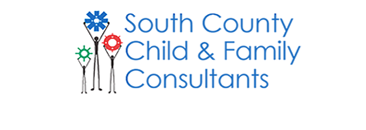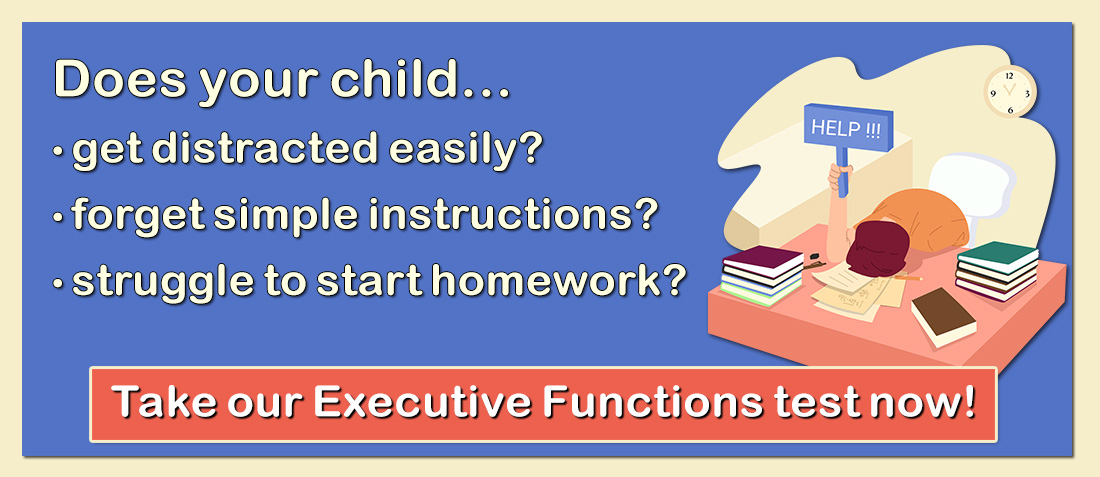
Response inhibition is the ability to cease or delay an action and to be able to reflect rather than display impulsive behavior. Simply put, response inhibition helps individuals to stop and think before acting. It also helps one to ignore outside interference. This skill allows a child to plan and display appropriate behaviors. Response inhibition is imperative in tasks such as maintaining safety, problem solving efficiently, and behaving in a socially appropriate manner. This skill is also needed for focusing on the task at hand, rather than reacting to other situations in the environment. Follow our recommendations below to improve response inhibition.
Home and School Situations Requiring Response Inhibition
- Raising one’s hand before answering a question in class
- Waiting for one’s turn to play in a game or to speak during a conversation
- Ignoring distractions while working on homework
- Putting a helmet on before getting on a bike
- Reading the directions before starting an assignment
- Being patient with a younger sibling
- Completing a long, multi-step task
- Waiting in line at school or at a store
- Keeping oneself from falling back asleep in the morning
- Not talking back to one’s parents when upset
Hints and Strategies to Improve Response Inhibition
1. Have your child think about their answer to a question a few seconds before they verbalize the answer. Teach your child to count to 10 before acting. Practice this by counting together out loud before making a decision.
2. Arrange for your child to play games with other children that require them to wait for their turn. An example of a game that involves patience can be “Chutes and Ladders.” An example of a game that involves both patience and concentration, (when counting the number of spaces to move) can be “Trouble.” “Chess” can also be helpful to improve concentration and patience because the game requires the player to be constantly thinking about their next move.
3. Take a break. Let your child take a break from a situation that is upsetting to them. Doing so will keep your child motivated, as well as keep them from growing upset and irritable. Your child may tend to become angry or upset, and possibly give up on a difficult assignment if they are being forced to complete it all at once. For example, if your child has to write a lengthy paper, giving him/her a 10 minute break will allow them to remove him/herself from the stressful situation and begin with a fresh start again after the break. Model the same procedure by showing your child how you take a break to handle a difficult or frustrating experience. Display your own strategies by walking away but later returning to solve a problem.
4. Model response inhibition for your child. Talk to your child about the strategies that you use to exhibit response inhibition and self-control and then model these strategies. For example, you may tell your child, “I really would like to watch TV… but I know I have to clean the basement first.” This will help show your child how to develop a form of response inhibition and structure.
5. Review homework assignment directions with your child so that they know what to do before starting. Discuss what needs to be done and help show your child how to follow the directions. If a teacher assigns a worksheet, have your child read the instructions to you and discuss them, rather than allowing your child to dive in without reading.
6. Encourage your child to play puzzle-based video games. Examples of puzzle-based games include the following: “Bejeweled,” “Tetris,” and “Bubblicious,” in which your child can earn bonus points by delaying a first response. Many of these puzzle games will reward patience when the player is able to combine a number of shapes that match or create a larger pattern rather than simply pairing the first two that fit with each other. Most importantly, ask your child to describe to you how (s)he can earn the maximum number of points; engage in a discussion about how inhibiting or delaying an action results in a higher game score.
7. Encourage high levels of activity during leisure time. Children who struggle with response inhibition often find themselves in trouble due to too much movement. Encouraging your child to exert him/herself when it is appropriate may help in getting your child to sit still when necessary. Teach your child basic yoga, meditation, or breathing techniques. Learning one or more of these strategies can be very useful for children who act before thinking. Regular practice of one or two small techniques is something that can be used in a situation where the child tends to respond quickly and get into trouble. Teaching one or two yoga stretches may be particularly helpful for children with movement-based response inhibition difficulties. For example, learning the “mountain” and “sun salutation” poses (which essentially consists of standing with one’s hands extended above the head and breathing) can be very useful for delaying actions. Further information about a number of yoga poses can be found on http://yoga.about.com.
Games and Activities That Can Practice Response Inhibition
“Choose Your Own Adventure” Books – Encourage your child to read any books in the “Choose Your Own Adventure” series, which will allow him to recognize how each decision made can lead to a distinct consequence.
Playing board games (e.g. “Trouble,” “Chutes and Ladder,” “Candyland”) – These, or similar games, will allow your child to practice waiting for their turn to play, while other players count spaces or play out their own turns.
“Dance Dance Revolution” and “Guitar Hero” – Both of these games enhance response inhibition in that the player must really concentrate and think about which note to play or square to step on in order to achieve success.
“Simon Says” – The traditional game of “Simon Says” will allow your child to practice delaying an action until the appropriate cue is heard.
Freeze Tag -Playing freeze tag with your child or having them play this game with friends or siblings will encourage the stop-and-start action of appropriate behaviors as well as the delaying of impulsive action.
Reading with a partner – Read with your child, alternating turns, to allow for practice in waiting for one’s turn and patience.
Websites and Articles on Response Inhibition
LearningWorks For Kids: The premier resource for executive function information, offering a detailed explanation of response inhibition, tips for parents, and activities to improve this skill.
Education.com: This site offers examples and techniques for parents to use when helping their children to develop self-control.
Illinois Early Learning Project: This site provides tips for instilling impulse control in their children, as well as links to other informative sites on related topics.
National Association of School Psychologists: This handout describes important step-by-step strategies and skills for parents and teachers who are hoping to teach self-control skills to children.
Books on Response Inhibition
Brain Hacks: Work Smarter, Stay Focused, and Achieve Your Goals by Lara Honos-Webb, PhD. (Ch. 6) “Filled with actionable strategies proven to improve focus, increase productivity, and promote well-being, Brain Hacks will help you transform the way you work, live, and feel by tapping into the power of your executive functioning skills.” – Amazon
Executive Functioning Skills Printables Workbook: For Students Learning Life Skills S.B. Linton (Pg. 43-49) “For teens and youth with special needs. These are Executive Functioning Skills Printables Worksheets for Students with Autism, Similar Special Needs, ADHD, LD and Executive Functioning Needs.”- Amazon
Executive Functioning Workbook for Kids: 40 Fun Activities to Build Memory, Flexible Thinking, and Self-Control Skills at Home, in School, and Beyond by Sharon Grand, PhD, BCN. (Ch. 5) “Help kids grow their executive functioning skills with activities for ages 6 to 9!”- Amazon
Focus & Thrive Executive Functioning Strategies for Teens by Laurie Chaikind McNulty, LCSW-C (Pt. 2) “Focus and Thrive is full of practical tools to help teens uncover strengths and develop executive functioning skills like staying focused, getting organized, making plans, and managing time.” -Amazon
Just As You Are: A Teen’s Guide To Self-Acceptance & Lasting Self-Esteem by Michelle Skeen, PsyD, Kelly Skeen.7 (Ch. 7) “Stop comparing yourself to others—you’re special just as you are! In this fun, practical guide, you’ll learn how to silence your nit-picky inner critic, cultivate self-compassion, and discover what really matters to you.” – Amazon
Knowing Yourself, Knowing Others: A Workbook for Children with Asperger’s Disorder, Nonverbal Learning Disorder, and Other Social-Skill Problems by Barbara Cooper, MPS, Nancy Widdows, MS. (Activities 18,19,22) “Knowing Yourself, Knowing Others includes activities that will help kids with Asperger’s disorder and related conditions learn how to read social cues, avoid meltdowns, understand others’ needs and intentions, resolve conflicts with friends, build basic nonverbal skills, and more.”- Amazon
NurtureShock: New Thinking About Children by Po Bronson & Ashley Merryman (Ch. 8) “With impeccable storytelling and razor-sharp analysis, they demonstrate that many of modern society’s strategies for nurturing children are in fact backfiring–because key twists in the science have been overlooked.”-Amazon
Playing Smarter in a Digital World: A Guide to Choosing and Using Popular Video Games and Apps to Improve Executive Functioning in Children and Teens by Randy Kulman, Ph.D. (Ch. 14) “A book to help parents to make their children’s digital playtime educational”- Amazon
Raising Independent, Self-Confident Kids: Nine Essential Skills to Teach Your Child or Your Teen by Wendy L. Moss, PhD, and Donald A. Moses, MD.(Ch. 5) “In this book, child development experts Wendy L. Moss, PhD, and Donald A. Moses, MD, examine the key skills parents need to help their kids emerge as confident, and capable adults.”- Amazon
Scattered to Focused: Smart Strategies to Improve Your Child’s Executive Functioning Skills by Zac Grisham (Ch. 4) “Set your child up for success with simple strategies to develop executive function in kids 4 to 12”- Amazon
Smart but Scattered: The Revolutionary “Executive Skills” Approach to Helping Kids Reach Their Potential by Peg Dawson, EdD, and Richard Guare, PhD (Ch. 11) “Small changes can add up to big improvements–this empowering book shows how.”- Amazon
The ADHD Workbook for Kids: Helping Children Gain Self-Confidence, Social Skills, and Self-Control (Instant Help Book for Parents & Kids) by Lawrence E. Shapiro, PH.D. (Section 1) “The ADHD Workbook for Kids offers a simple way to help children with ADHD learn these critical skills in just ten minutes a day.” – Amazon
The Conscious Parent’s Guide To Executive Functioning Disorder by Rebecca Branstetter, PhD (Ch. 5) “With the strategies and advice in this guide, you and your child will build sustainable bonds, develop positive behaviors, and improve executive functioning skills for life.” – Amazon
The Everything Parent’s Guide to Children with Executive Functioning Disorder: Strategies to help your child achieve the time-management skills, … needed to succeed in school and life by Rebecca Bransetter, PhD.(Ch. 6) “The vital skills children need to achieve their full potential!” – Amazon
Train Your Brain for Success: A Teenager’s Guide to Executive Functions by Randy Kulman, Ph.D. (Ch. 7) “ Beginning with a test to determine executive-functioning strengths and weaknesses, the book then explores in detail eight distinct sets of skills, including planning, organization, focus, time management, self-control, , memory, and self-awareness.”- Amazon
Tween You & Me: A Preeteen Guide to Becoming Your Best Self by Deb Dunham. (Ch. 4) “In this positive and empowering book, Deb Dunham, tween self-esteem expert and mentor, provides the tools you need to feel really good about yourself.” – Amazon
Receive online class information and helpful tips from Dr. Randy Kulman's LearningWorks for Kids |



